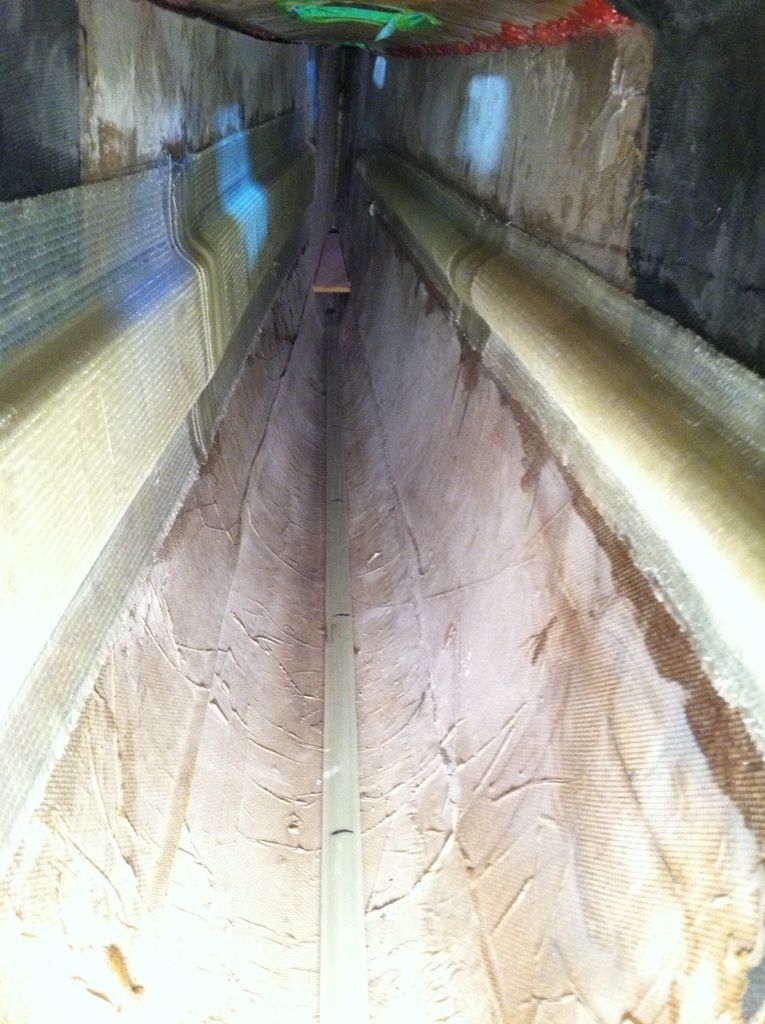I don't know about fire damage, I don't really see any evidence of that, but definitely some pretty bad delamination. Like srm said, this boat might be nearing the end of it's life. I'd check for soft spots elsewhere (they aren't always visible like the ones at the bow... try pressing on the sides of the hulls and the deck). If it's noticeably soft, that's a soft spot that needs to be repaired. A couple spots here and there are manageable, but if it's pervasive and covers a large portion of the decks or sides, the boat might be beyond saving.
I also agree with srm on the mold, my boat has it too, to some degree. I imagine most do after a few decades! The glue that holds the deck to the hull at the seams and daggerboard trunk might also be black (mine is).
The hulls were definitely painted at one time, probably because they were significantly chalky/faded from sun exposure. Colored hulls are tough to restore, so someone probably decided to just paint it instead. They put quite a bit of time into it, and they look really nice, but it belies the actual condition of the hulls underneath.
Aftermarket (sunrise) sails (or jib at least), not faded noticeably, so they should have some good life left in them. New trampoline, lacing and rigging, all in good shape. Rudder pin looks like it's been chopped down for some reason, doesn't look like it goes all the way up. May want to replace it.
Rollers on the trailer should be changed out for bunks soon, as the boat is too heavy for rollers and they can cause damage to the bottoms of the hulls over the long term, or when stepping the mast on the trailer.
If this were my boat, I'd concentrate on the serious structural concerns. Check the hull lips to make sure they're not separating, splitting or flexing. The soft spots are a big structural problem. If they can't be fixed, there's no point in going any further. But if there aren't too many and you manage to repair them to the point that they're solid again and don't flex, then I'd rig the boat and try sailing in some light to moderate conditions, close to shore on a warm, calm day with a chase boat. Check the hulls for leaks. If all is good after an hour, check the hulls at the end of the day. If you're lucky, and the bows can be repaired, the boat can still last you a good while!
With regards to the soft spots: Check the sides and deck. You should be able to push HARD without it feeling soft or spongy, or hearing crunching noises. If they're not too large or too many, you can repair them with epoxy. When you find one, cover the area with masking tape and start pressing, see if you can figure out (and trace) the outline of the soft area. Then mark spots for holes ever 1-2" just on the inside of the line. Mark one spot in the center of the soft spot. Drill a hole at each marking, careful only to penetrate the outer layer of fiberglass. twirl the drill bit in the hole with your finger tips and very light pressure to drill through the foam as well. Then mix up a batch of epoxy (or several) and start injecting it into the center hole only. Keep injecting until it starts coming out of the breather holes around the perimeter. Cover each hole in succession when epoxy starts coming out of them, to force it to flow to the next hole. When the entire area is done, let it sit to cure. If the soft spot is large, you may need to "pump" on the soft spot a few times to get the epoxy to flow to the breather holes, but be careful not to let the soft spot suck air through the center hole.
It's worth noting that this repair is technically the "easy fix." A "proper" fiberglass repair involves cutting out the soft spot and laying new fiberglass and new foam, which is very intricate and expensive and should only be done by a professional, as hammond said. The cost of such a repair is likely far more expensive than finding a replacement boat, and it's no guarantee that another part of the boat won't suffer a similar problem in a year or two.
If the soft spots are very large, or there are a lot of them, the hulls are unfortunately shot. However, the parts that came with/on this boat are fortunately in great shape! Save them as spares or replacement parts for the next one you come across with hulls in good shape!








.jpg)





